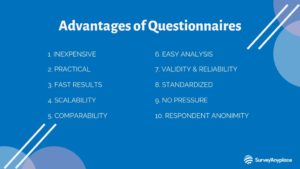#2 Designing Surveys
Surveys are a very effective way to collect data while also saving time and even money. Surveys can also be sent out to people across the country and even the globe, which helps get a wider basis of answers and more accurate, representative data. Surveys are usually online or through mail, which is convenient for those on the go or who are rushing to complete them. Other traditional methods, such as focus groups and interviews, can discourage people from participating because they are seen as a huge time consumer and in today’s society, as it has always been, time is money. Surveys are very practical, especially with today’s technology (for example, Google Surveys). Though the effortless forms of surveys, whether in person or online, is seen universally as a good thing, those taking the surveys will obviously not share the same world views, and their answers will differ. Even two siblings taking the same survey could have completely different answers based on their personal beliefs, and the exposure to the topic(s) they are being asked about. Gender does play a role in how we see the world. As females, we are portrayed as weak and very dependent on men. We care immensely about our rights and issues related to us, such as domestic violence. Men are more focused on their own gender problems, which they do not have a lot of. Unless they are an activist or just very woke, there is a slim chance that they will think certain issues are of importance. The same theory applies with race and social class, in that the issues that apply to certain people will matter more to them than those issues that don’t. For example, those who can not afford health care are most certainly fans of universal/free healthcare, while those who can afford it with ease probably don’t spend as much time thinking about the issue. Those who struggle to make ends meet will most likely fight harder for more rights and help for the poor than those who can spend money with ease. Our race, gender, and social class affect the way we view the world and in turn, affect how we would answer potential survey questions.

This graphic, taken from the SurveyAnyplace Blog, (1) shows the most basic advantages of surveys. With the anonymity of surveys, such as the one we made for class, people are less afraid to speak their minds. When a survey taker knows that their name or a certain characteristic of themselves will be associated with the answers they give, they are less likely to speak their true mind, especially if the opinions they hold are controversial. When the surveys are anonymous, there is a higher chance of the questions being answered completely and honestly, which helps the data remain accurate. Though, as stated before, those of different genders, races, and social classes will have different answers, the style of surveys allow those answering them to speak their true mind and save time while doing it.
References
[1] “10 Advantages and Disadvantages of Questionnaires.” Survey Anyplace, August 20, 2019. https://surveyanyplace.com/questionnaire-pros-and-cons/.